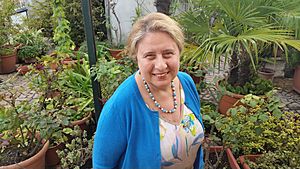Elisabetta Brusa facts for kids
Elisabetta Olga Laura Brusa (born 3 April 1954) is a well-known Italian and British composer. She creates beautiful music, especially for orchestras.
Contents
Early Life and Musical Journey
Elisabetta Brusa was born in Milan, Italy. Even as a child, she loved music and wrote 32 pieces for the piano. She later studied composition at the Milan Conservatory. Her teachers included Bruno Bettinelli and Azio Corghi. Bettinelli also taught famous Italian conductors like Claudio Abbado and Riccardo Muti. Elisabetta finished her studies in 1980.
After graduating, she taught composition at music schools in Vicenza, Mantova, and Brescia. In 1985, she began teaching at the Conservatorio of Milan. She also learned from important musicians like Sir Peter Maxwell Davies and Hans Keller. In 1983, she appeared on a TV show called Young Italian Composers.
Awards and Recognition
Elisabetta Brusa won her first major award in 1982. She took first prize at the Washington International Competition for Composition for String Quartet. This win led to more opportunities. The next year, she received a special award from the Fromm Music Foundation. She also got a fellowship from the U.S.-Italy Fulbright Commission. These allowed her to attend composition classes at the Tanglewood Music Center in the United States. Later, she received three more fellowships from the MacDowell Colony. In 1997, she married the conductor Gilberto Serembe.
Musical Style and Works
Elisabetta Brusa is famous for her orchestral music. Many of her works have been recorded by Naxos Records. She often finds ideas for her music in books, art, and other music. However, she never directly copies or imitates these inspirations.
Her musical style is often described as "Neo-Tonality" or "Neo-Romanticism." This means her music sounds modern but still uses traditional melodies and harmonies. She uses a wide range of notes in her music, creating rich and colorful sounds.
Some of her notable works include:
- Two Symphonies
- A Requiem (music for a memorial service)
- A Stabat Mater (a religious piece)
- Florestan: This tone poem is inspired by a character from the composer Robert Schumann's personality.
- Nittemero Symphony: This symphony gets its name from ancient Greek words for "night" and "day."
- Messidor: This piece reminds listeners of Felix Mendelssohn's music for A Midsummer Night's Dream. She dedicated this work to her husband.
- Other pieces like "Fanfare," "Adagio," "Firelights," "Requiescat," "Favole," "Merlin," and "Simply Largo." These pieces are written for orchestras of different sizes.
Performances Around the World
Elisabetta Brusa's music has been performed by many famous orchestras. These include the BBC Symphony Orchestra, the Hungarian Radio Symphony Orchestra, and the Atlanta Symphony Orchestra. Her works have also been played by the Ulster Orchestra, the BBC Philharmonic, and the BBC Scottish Symphony Orchestra. Other orchestras that have performed her music include the Royal Scottish National Orchestra, the CBC Vancouver Orchestra, the State Hermitage Orchestra, and the St. Petersburg Symphony Orchestra. The Tanglewood Music Center Orchestra and The Women's Philharmonic of San Francisco have also featured her compositions.
Notable Recordings
- Orchestral Works, volume 1 (Florestan, Messidor, La Triade, Nittemero Symphony, Fanfare): Naxos 8.555266, 21st Century Classics
- Orchestral Works, volume 2 (Firelights, Adagio, Wedding Song, Requiescat, Suite Grotesque, Favole): Naxos 8.555267, 21st Century Classics
- Orchestral Works, volume 3 (Symphony No.1, Merlin): Naxos 8.573437, 21st Century Classics
- Orchestral Works, volume 4 (Symphony No.2, Simply Largo): Naxos 8.574263, 21st Century Classics
- Orchestral Works, volume 5 (Requiem, Stabat Mater): Naxos 8.574589, 21st Century Classics


